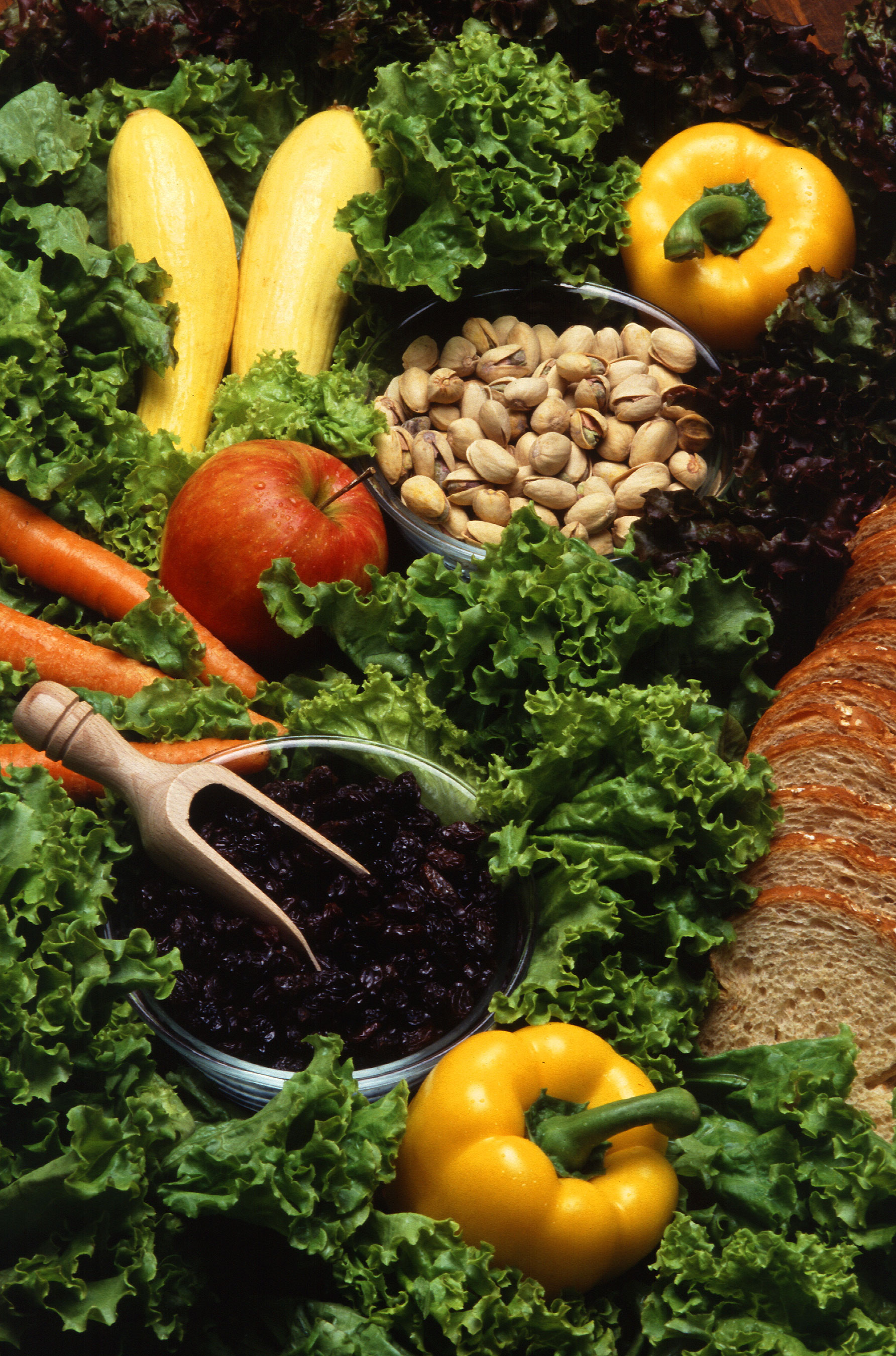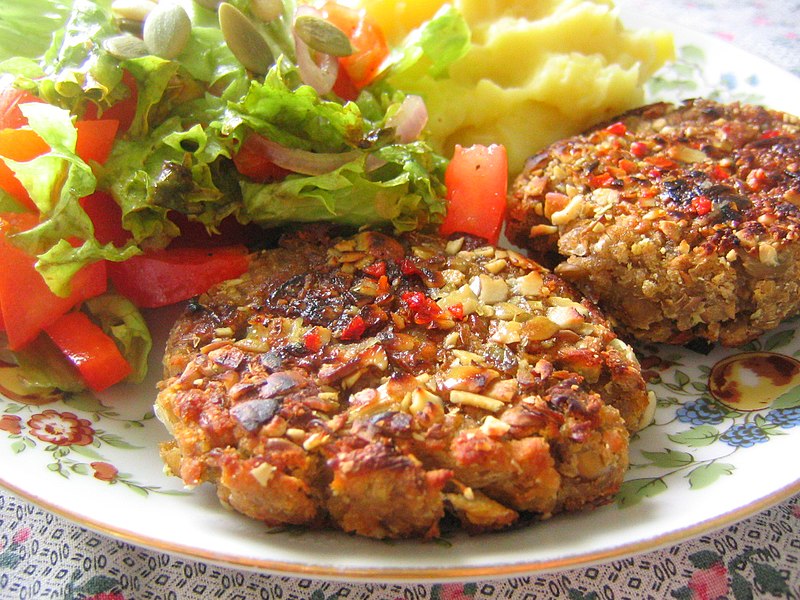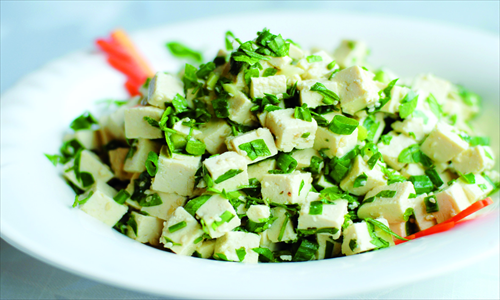Biography Source google.com.pk
Vegetarian cuisine
A variety of vegetarian food ingredients that are also vegan.
Vegetarian cuisine refers to food that meets vegetarian standards by not including meat and animal tissue products. For lacto-ovo vegetarianism (the most common type of vegetarianism in the Western world), eggs and dairy products such as milk and cheese are permitted. For lacto vegetarianism, the earliest known type of vegetarianism (recorded in India), dairy products such as milk and cheese are permitted.[1] The strictest forms of vegetarianism are veganism and fruitarianism, which exclude all animal products, including dairy products as well as honey, and even some refined sugars if filtered and whitened with bone char.
Foods used in vegetarian cuisine
Vegetable soup and cheese sandwich, a meal which is suitable for vegetarians but not vegans
Food regarded as suitable for all vegetarians (including vegans) typically includes:
Cereals/grains: maize, hempseed, corn, wheat, rice, barley, sorghum, millet, oats, rye, triticale, buckwheat, fonio, quinoa; derived products such as flour (dough, bread, pasta, baked goods).
Vegetables (fresh or pickled); derived products such as vegetable oils
Edible fungi
Fruit (fresh or dried)
Legumes: beans (including soybeans and soy products such as tempeh, tofu, soy milk, and TVP), chickpeas, peas, lentils, peanuts)
Tree nuts and seeds
Spices and herbs
Other foods such as seaweed (however seaweed is considered inedible by some strict vegetarians for the same reason it can be considered to be non-kosher by some: the possibility that various tiny animals may be found adhering to it.)
Foods not suitable for vegan vegetarians, but for some other types of the vegetarian cuisine:
Vegetarian cuisine
These are some of the most common dishes that vegetarians eat without substitution of ingredients. Such dishes include, from breakfasts to dinnertime desserts:
Vegetarian food products made from cereal grains.
Traditionally, Brahmin cuisines in most part of India, except West Bengal, are strictly vegetarian.
Gujarati cuisine from the state of Gujarat in western India is predominantly vegetarian.
Many bean, pasta, potato, rice, and bulgur/couscous dishes, stews, soups and stir-fries.
Cereals and oatmeals, granola bars, etc.
Fresh fruit and most salads
Potato salad, baba ganoush, pita-wraps or burrito -wraps, vegetable pilafs, baked potatoes or fried potato-skins with various toppings, corn on the cob, smoothies
Many sandwiches, such as cheese on toast, and cold sandwiches including roasted eggplant, mushrooms, bell peppers, cheeses, avocado and other sandwich ingredients
Many side dishes, such as mashed potatoes, scalloped potatoes, some bread stuffings, seasoned rice, and macaroni and cheese.
Classical Buddhist cuisine in Asia served at temples and restaurants with a green sign indicating vegetarian food only near temples
National cuisines
Buddha's delight, a famous Chinese vegetarian dish.
Chinese (and other East Asian) dishes based on the main ingredients being mushroom, noodles, eggplant, string beans, broccoli, rice, tofu or mixed vegetables
Indian cuisine in Asia is replete with vegetarian dishes, many of which can be traced to religious traditions (such as Jain and Hindu). Gujarati cuisine of India is predominantly vegetarian among other Indian cuisines: Gujarati thali is very famous among Indians. There are many vegetarian Indian foods such as pakora, samosa, khichris, Pulao, raitas, rasam, bengain bharta, chana masala, some kormas, sambars, jalfrezis, saag aloo, subjis (vegetable dishes) such as bindi subji, gobi subji, Punjabi chole, aloo matar and much South Indian food such as dosas, idlis and vadas. Chapati and other wheat/maida based breads like naan, roti parathas are often stuffed with vegetarian items to make it a satisfying meal. Many Indian dishes also qualify as vegan, though many others use honey or dairy.
South Indian foods like sambar, rasam, koottu, karembadu, upma, palya/taalimpu, kozhambu/koora, aviyal, olan, Kadala curry, Theeyal, Pulihora/puliyogare, Chammandi, Chutney, Chitrannams and breads like Appam, Puttu, pathiri, dosa, idli and vada.
Sautéed tempeh with green beans, an Indonesian dish
In Indonesia, vegetarianism is well served and represented, as there are plenty selection of vegetarian dishes and meat substitutes. Dishes such as gado-gado, karedok, ketoprak, pecel, urap, rujak and asinan are vegetarian. However, for dishes that use peanut sauce, such as gado-gado, karedok or ketoprak, might contains small amount of shrimp paste for flavor. Served solely, gudeg can be considered a vegetarian food, since it consists of unripe jackfruit and coconut milk. Fermented soy products, such as tempeh, tofu and oncom are prevalent as meat substitutes, as the source of protein. Most of Indonesians do not practice strict vegetarianism and only consume vegetables or vegetarian dishes for their taste, preference, economic and health reasons. Nevertheless, there are small numbers of Indonesian Buddhists who practice vegetarianism for religious reason.
Japanese foods such as tempura, edamame, name kojiru, and vegetable sushi. Miso soup is made from fermented white or red soy bean paste, garnished with scallions or seaweed. Although most traditional versions are made from fish stock (dashi), it can be made with vegetable stock as well.
Korean cuisine has many dishes that are entirely composed of vegetarian ingredients. It includes bibimbap, rich in vegetables and low-fat, jeon, which can be easily understood as Korean version of pizza, made with kimchi, or with seafood and leek, and many others.
Cuisine of the Mediterranean such as tumbet and many polentas and tapas dishes
Mexican foods such as salsa and guacamole with chips, rice and bean burritos (without lard in the refried beans or chicken fat in the rice), huevos rancheros, veggie burrito, many quesadillas, bean tacos, some chilaquiles and bean-pies, chili sin carne, black beans with rice, some chiles rellenos, cheese enchiladas and vegetable fajitas
Italian foods such as most pastas, many pizzas, crostini, bruschetta, many risottos, Parmigiana
Continental cuisine such as ratatouille, braised leeks with olives and parsley, many quiches, sauteed Swiss chard, vegetable-stuffed mushrooms, sauteed Brussels sprouts with mushrooms and squash
In Germany, Frankfurt green sauce, Klöße with vegetarian sauces (e.g., Chanterelle), combinations of quark, spinach, potatoes and herbs provide some traditional vegetarian summer dishes. Traditionally on Fridays, southern Germany broad variety of sweet dishes may be served as a main course, so Germknödel and Dampfnudel. Potato soup and plum cake is a traditional Friday course in the Palatinate.
Many Greek and Balkan dishes, such as dolmas (when made without minced meat), spanakopita and fasolada
Tolstoy's vegetarian breakfast
Russian cuisine developed a significant vegetarian tradition in czarist time, based on the example of Leo Tolstoy.[3] The orthodox tradition of separating meat and vegetables and as well between specific meals for fasting and other holidays contributed to a rich variety of vegetarian dishes[3] in Russia and Slavic countries, such as soups (vegetable borscht, shchi, okroshka), pirogi, blini, vareniki, kasha, buckwheat, fermented and pickled vegetables, etc.
Many Ethiopian dishes
Mideastern food such as falafel, hummus (mashed chick peas), tahini (ground sesame seeds), minted-yogurts, and couscous.
Egyptian cuisine in particular is rich in vegetarian foods. For reasons ranging from economics to the religious practices of the Coptic Orthodox Church, most Egyptian dishes rely on beans and vegetables: the national dishes, kushari and ful medames, are entirely vegetarian, as are usually the assorted vegetable casseroles that characterize the typical Egyptian meal.
Many dishes in Thai cuisine can be made vegetarian if the main protein element is substituted by a vegetarian alternative such as tofu. This includes dishes such as phat khi mao and, if a vegetarian shrimp paste and fish sauce substitute is used, many Thai curries. Venues serving vegetarian Buddhist cuisine (ahan che; Thai: อาหารเจ) can be found all over Thailand.
Creole and Southern foods such as hush puppies, okra patties, rice and beans, or sauteed kale or collards, if not cooked with the traditional pork fat or meat stock.
Some Welsh recipes, including Glamorgan sausages, laverbread and Welsh rarebit.
Palatschinken with ice cream, fruits and fruit compote from Austria
Desserts and sweets
Most desserts, including pies, cobblers, cakes, brownies, cookies, truffles, Rice Krispie treats (from gelatin-free marshmallows or marshmallow fluff), peanut butter treats, pudding, rice pudding, ice cream, crème brulée, etc., are free of meat and fish and are suitable for ovo-lacto vegetarians. Eastern confectionery and desserts, such as halva and Turkish delight, are mostly vegan, while others such as baklava (which often contains butter) are lacto vegetarian. Indian desserts and sweets are mostly vegetarian like peda, barfi, gulab jamun, shrikhand, basundi, kaju katri, rasgulla, cham cham, rajbhog, etc. Indian sweets are mostly made from milk products and are thus lacto vegetarian; dry fruit-based sweets are vegan.
Cuisine that uses meat analogues[edit]
Morningstar Farms tomato and basil pizza veggie burgers garnished with onion, ketchup and Cheddar.
These are vegetarian versions of popular dishes that non-vegetarians enjoy and are frequently consumed as fast food, comfort food, transition food for new vegetarians, or a way to show non-vegetarians that they can be vegetarians while still enjoying their favorite foods. Many vegetarians just enjoy these dishes as part of a varied diet.
Some popular mock-meat dishes include:
Veggie burgers (burgers usually made from grains, TVP, seitan (wheat gluten), tempeh or mushrooms)
Veggie dogs (usually made from TVP)
Imitation sausage (soysage, various types of 'salami', 'bologna', 'pepperoni', et al., made of some form of soy)
Mockmeat or 'meatyballs' (usually made from TVP)
Vegetarian or meatless 'chicken' (usually made from seitan, tofu or TVP)
Jambalaya (with mock sausage and mock chicken, usually made from TVP, seitan, or tempeh)
Tomato omelette where tomatoes and a paste of flour are used to produce a vegetable omelette without the use of eggs.
Scrambled eggs where tofu is mashed and fried with spices (often including turmeric, for its strong yellow color) to produce a dish that strongly resembles eggs.
When baking, eggs are easily replaced by ground flax seeds, applesauce, mashed bananas, or commercial egg replacer
Mycoprotein is another common base for mock-meats, and vegetarian flavorings are added to these bases, such as sea vegetables for a seafood taste.
Commercial products
Labeling used in India to distinguish vegetarian products (left) from non-vegetarian products (right).
Commercial products, marketed especially towards vegetarians and labeled as such, are available in most countries world wide, in varying amounts and quality. As example, in Australia, various vegetarian products are available in most of supermarket chains and a vegetarian shopping guide is provided by Vegetarian/Vegan Society of Queensland.[4] However, the biggest market for commercially vegetarian-labeled foods is India, with official governmental laws regulating the "vegetarian" and "non vegetarian" labels.
Vegetarian Food Recipes
Vegetarian Food Recipes
Vegetarian Food Recipes
Vegetarian Food Recipes
Vegetarian Food Recipes
Vegetarian Food Recipes
Vegetarian Food Recipes
Vegetarian Food Recipes
Vegetarian Food Recipes
Vegetarian Food Recipes
Vegetarian Food Recipes
Vegetarian Food Recipes
Vegetarian Food Recipes
Vegetarian Food Recipes
Vegetarian Food Recipes
Vegetarian Food Recipes
Vegetarian Food Recipes














No comments:
Post a Comment